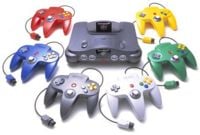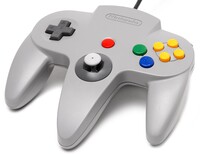Nintendo 64: Difference between revisions
No edit summary |
|||
| Line 11: | Line 11: | ||
[[Image:N64 Logo.png|left|thumb|The official '''Nintendo 64''' logo.]] | [[Image:N64 Logo.png|left|thumb|The official '''Nintendo 64''' logo.]] | ||
The Nintendo 64 was very popular for many reasons, one of the big ones being the release of ''[[Super Mario 64]]''. ''Super Mario 64'' was one of the first games of its kind to feature full 3D graphics and depth of field effects. The Nintendo 64 was able to pull this off because it was the first system to feature a 64-Bit processor and | The Nintendo 64 was very popular for many reasons, one of the big ones being the release of ''[[Super Mario 64]]''. ''Super Mario 64'' was one of the first games of its kind to feature full 3D graphics and depth of field effects. The Nintendo 64 was able to pull this off because it was the first system to feature a 64-Bit processor and 64-bit graphics chip (aside from the failed Atari Jaguar, which was really 32-bit) The Nintendo 64 also featured the first successful analog control sticks, and four built-in controller ports. The Nintendo 64 was also noted as the last home console system to use cartridges, before Nintendo started using discs like its competitors. | ||
The Nintendo 64 hosted a wide variety of games, but most of its hits were first-party titles such as ''[[Super Mario 64]]'', ''[[Super Smash Bros.]]'', ''[[Mario Kart 64]]'', ''[[Mario Party]]'', ''[[Paper Mario]]'', ''Star Fox 64'', ''Legend of Zelda: Ocarina of Time'' and ''F-Zero X''. [[Rareware]], however, developed quite a few hits for the N64, such as ''Goldeneye 007'', ''[[Banjo-Kazooie]]'' and ''[[Donkey Kong 64]]''. Production ended in 2002. The Nintendo 64 sold | The Nintendo 64 hosted a wide variety of games, but most of its hits were first-party titles such as ''[[Super Mario 64]]'', ''[[Super Smash Bros.]]'', ''[[Mario Kart 64]]'', ''[[Mario Party]]'', ''[[Paper Mario]]'', ''Star Fox 64'', ''Legend of Zelda: Ocarina of Time'' and ''F-Zero X''. [[Rareware]], however, developed quite a few hits for the N64, such as ''Goldeneye 007'', ''[[Banjo-Kazooie]]'' and ''[[Donkey Kong 64]]''. Production ended in 2002. The Nintendo 64 sold 31.93 million units during its lifetime. | ||
[[Image:N64system.jpg|thumb|left| The original '''Nintendo 64''', and its six controller colors.]] | [[Image:N64system.jpg|thumb|left| The original '''Nintendo 64''', and its six controller colors.]] | ||
Revision as of 09:25, January 13, 2011
If you were looking for the treasure from Wario World, see here. Template:System-Infobox The Nintendo 64 was a video game console created by Nintendo. It was released in 1996 to compete with the Sega Saturn and PlayStation.
The Nintendo 64 was very popular for many reasons, one of the big ones being the release of Super Mario 64. Super Mario 64 was one of the first games of its kind to feature full 3D graphics and depth of field effects. The Nintendo 64 was able to pull this off because it was the first system to feature a 64-Bit processor and 64-bit graphics chip (aside from the failed Atari Jaguar, which was really 32-bit) The Nintendo 64 also featured the first successful analog control sticks, and four built-in controller ports. The Nintendo 64 was also noted as the last home console system to use cartridges, before Nintendo started using discs like its competitors.
The Nintendo 64 hosted a wide variety of games, but most of its hits were first-party titles such as Super Mario 64, Super Smash Bros., Mario Kart 64, Mario Party, Paper Mario, Star Fox 64, Legend of Zelda: Ocarina of Time and F-Zero X. Rareware, however, developed quite a few hits for the N64, such as Goldeneye 007, Banjo-Kazooie and Donkey Kong 64. Production ended in 2002. The Nintendo 64 sold 31.93 million units during its lifetime.
In 2003, the so-called iQue Player was released in the Chinese market only, serving as the Chinese equivalent of the Nintendo 64, albeit with a differently designed controller. Its D-Pad and analog stick are placed as on the Nintendo GameCube controller[1]. The entire system only consists of the controller, which has the chip on-board. It has a limited selection of Mario titles, all of which were released for the Nintendo 64 outside China. These include Super Mario 64, Mario Kart 64, Paper Mario, Yoshi's Story, Dr. Mario 64 and Super Smash Bros.
The Nintendo 64 has made a few appearances in Mario games as an easter egg. A Nintendo 64 appears in Super Smash Bros. Melee in the background of the stand where all of the player's trophies are. Francis, from Super Paper Mario also owns a Nintendo 64 as well as a Nintendo GameCube, Virtual Boy and Wii. In Super Smash Bros. Brawl, one of the names that can appear whenever a player presses the random button when they're naming their custom stage is N64, which is a reference to the old system.
Nintendo 64 Controller
The Nintendo 64 Controller is the standard controller for the Nintendo 64. It is unique among Video Game controllers, as it has three grips instead of the more common two, this was most likely done because Nintendo was worried that 3D gaming wouldn't catch on, so they made a separate grip for the + Control Pad. There are many color variations of the controllers, including solid colors and clear colors, the many different colored controllers being a unique concept at the time.
Contrary to popular belief, the Nintendo 64 was not the first console to use analog control sticks, it was just the first successful console to use them. The Vectrex was the first home console to have an analog stick; it also had four controller ports, something else that wasn't popularized until the Nintendo 64.
Buttons
- A
- B
- C up, down, left, and right
- START
- Z
- R
- L
- Analog Stick
- + Control Pad
Gallery
- BanjoKazooie.jpg
- Badfurday.jpg
- MG64.PNG
- Nintendo 64-mario kart 64.jpg
- MP1 Cover.png
- MP2BOX.PNG
- MP3BOX.PNG
- MT64.PNG
- Papermario.jpg
- 260px-Super Mario 64 box cover.jpg
- SuperSmashBros.JPG
- YS Cover.jpg






